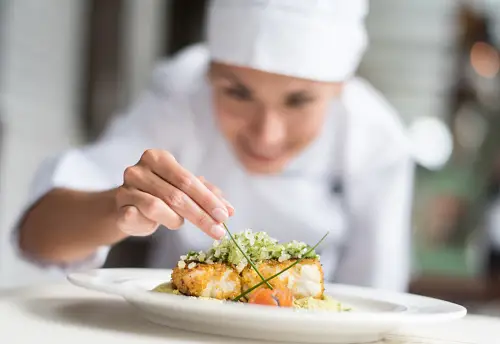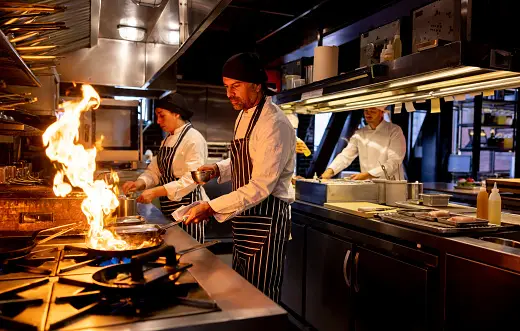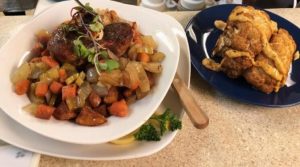Gourmet cooking at home is a delightful and rewarding pursuit that allows you to transform everyday meals into extraordinary culinary experiences. By incorporating fresh, high-quality ingredients and mastering various cooking techniques, you can create dishes that rival those found in top restaurants. This guide provides comprehensive tips and tricks to help you elevate your home cooking, from essential kitchen tools and advanced cooking methods to plating techniques and recipe ideas. Whether you’re a seasoned home cook or a beginner eager to learn, these insights will inspire you to explore new flavors and achieve gourmet excellence in your own kitchen.
Understanding Gourmet Cooking
What is Gourmet Cooking?
Gourmet cooking refers to the preparation of high-quality meals that use premium ingredients and advanced culinary techniques. It’s not just about the complexity of the dish but also about the presentation, taste, and overall dining experience.
The Importance of Fresh Ingredients
One of the key aspects of gourmet cooking is the use of fresh, high-quality ingredients. Fresh ingredients not only enhance the flavor of the dish but also contribute to the nutritional value of the meal.
Essential Tools for Gourmet Cooking
Must-Have Kitchen Equipment
To create gourmet meals, having the right tools is essential. Here’s a list of must-have kitchen equipment:
- Chef’s Knife: A sharp, high-quality chef’s knife is crucial for precision and efficiency.
- Cast Iron Skillet: Perfect for searing, baking, and frying.
- Food Processor: Ideal for chopping, slicing, and blending.
- Sous Vide Machine: Allows precise temperature control for perfectly cooked meats and vegetables.
- Stand Mixer: Great for baking and mixing ingredients thoroughly.
Specialty Tools for Advanced Techniques
For more advanced gourmet cooking, consider investing in specialty tools such as:
- Mandoline Slicer: For thin, uniform slices of vegetables.
- Blow Torch: Perfect for caramelizing sugar on desserts or finishing meats.
- Immersion Blender: For smooth soups and sauces.
- Pasta Maker: To create fresh, homemade pasta.
Techniques for Gourmet Cooking
Mastering Basic Cooking Techniques
Before diving into advanced techniques, it’s important to master basic cooking skills:
- Sautéing: Cooking food quickly in a small amount of oil over high heat.
- Roasting: Cooking food in the oven at high temperatures to achieve a caramelized exterior.
- Braising: Cooking meat slowly in a small amount of liquid to make it tender and flavorful.
- Poaching: Gently cooking food in simmering liquid.
Exploring Advanced Techniques
Once you’ve mastered the basics, try incorporating these advanced techniques:
- Sous Vide: Cooking food in a vacuum-sealed bag submerged in water at a precise temperature.
- Molecular Gastronomy: Using scientific principles to create innovative dishes (e.g., spherification, foams).
- Confit: Slow-cooking meat in its own fat to achieve tender, flavorful results.
- Fermentation: Using microorganisms to develop complex flavors in foods like kimchi and sourdough bread.
Ingredients for Gourmet Cooking
Sourcing High-Quality Ingredients
To elevate your dishes, it’s important to source the best ingredients possible:
- Farmers Markets: Offer fresh, locally grown produce.
- Specialty Stores: Provide access to unique and high-quality ingredients.
- Online Suppliers: Great for hard-to-find items like truffles, exotic spices, and specialty meats.
Understanding Flavor Profiles
A key aspect of gourmet cooking is understanding and balancing flavor profiles:
- Sweet: Found in fruits, sugars, and some vegetables.
- Salty: Comes from salt, soy sauce, and certain cheeses.
- Sour: Present in citrus fruits, vinegar, and fermented foods.
- Bitter: Found in dark leafy greens, coffee, and certain spices.
- Umami: A savory taste present in mushrooms, tomatoes, and aged cheeses.
Presentation and Plating
The Art of Plating
Presentation is a crucial element of gourmet cooking. Here are some tips for beautiful plating:
- Balance: Create visual harmony by balancing colors, shapes, and textures.
- Negative Space: Use empty space on the plate to highlight the food.
- Garnishes: Add edible garnishes like herbs, microgreens, or sauces for an extra touch of elegance.
Creative Plating Ideas
Experiment with different plating styles to enhance the dining experience:
- Vertical Plating: Stack ingredients to create height and visual interest.
- Deconstructed Dishes: Present components separately to showcase individual elements.
- Thematic Plating: Design the plate to reflect the theme or origin of the dish.
Recipes for Gourmet Cooking at Home
Starter: Lobster Bisque
Ingredients:
- 2 lobsters
- 1 onion, chopped
- 2 carrots, chopped
- 2 celery stalks, chopped
- 4 cups seafood stock
- 1 cup heavy cream
- 1 cup white wine
- 2 tbsp tomato paste
- 1 tsp paprika
- Salt and pepper to taste
Instructions:
- Cook lobsters in boiling water until shells are bright red. Remove meat and set aside.
- Sauté onions, carrots, and celery in butter until softened.
- Add seafood stock, wine, tomato paste, and paprika. Simmer for 30 minutes.
- Blend mixture until smooth, then strain.
- Stir in heavy cream and lobster meat. Season with salt and pepper.
Main Course: Beef Wellington
Ingredients:
- 2 lbs beef tenderloin
- 1 lb puff pastry
- 1/2 lb mushrooms, finely chopped
- 4 slices prosciutto
- 1 egg, beaten
- Dijon mustard
- Salt and pepper to taste
Instructions:
- Sear the beef tenderloin on all sides. Brush with Dijon mustard.
- Sauté mushrooms until moisture evaporates.
- Lay prosciutto slices on plastic wrap, spread mushrooms on top, and place beef on mushrooms.
- Roll the beef tightly in prosciutto and mushrooms.
- Wrap the beef in puff pastry, sealing the edges.
- Brush with beaten egg and bake at 425°F for 25-30 minutes.
Dessert: Crème Brûlée
Ingredients:
- 2 cups heavy cream
- 5 egg yolks
- 1/2 cup sugar
- 1 vanilla bean
- 1/4 cup sugar (for topping)
Instructions:
- Preheat oven to 325°F.
- Heat cream and vanilla bean until simmering.
- Whisk egg yolks and sugar until pale and thick.
- Gradually add cream to egg mixture.
- Strain and pour into ramekins.
- Bake in a water bath for 40-45 minutes.
- Chill, then sprinkle sugar on top and caramelize with a blow torch.
Enhancing Your Gourmet Experience
Pairing Food and Wine
Wine pairing can enhance the flavors of your gourmet dishes. Here are some basic guidelines:
- White Wine: Pairs well with seafood, poultry, and light sauces.
- Red Wine: Complements red meats, rich sauces, and hearty dishes.
- Sparkling Wine: Versatile and pairs with a wide range of foods from appetizers to desserts.
Hosting a Gourmet Dinner Party
Hosting a gourmet dinner party can be a wonderful way to share your culinary creations with friends and family. Consider these tips for a successful event:
- Menu Planning: Choose a cohesive menu with complementary dishes.
- Preparation: Prepare as much as possible in advance to minimize stress on the day of the event.
- Ambiance: Create a comfortable and elegant dining environment with appropriate lighting, table settings, and background music.
Troubleshooting Common Issues
Dealing with Overcooked Meat
If you accidentally overcook meat, here are some ways to salvage the dish:
- Slicing Thinly: Thin slices can make overcooked meat more palatable.
- Adding Sauce: A flavorful sauce can add moisture and enhance the taste.
- Repurposing: Use overcooked meat in dishes like stews, casseroles, or sandwiches.
Correcting Seasoning Mistakes
If you over-season a dish, try these remedies:
- Diluting: Add more of the base ingredient (e.g., broth, water) to dilute the seasoning.
- Balancing Flavors: Add ingredients that counteract the strong flavor (e.g., adding sugar to balance excessive saltiness).
- Starting Over: In extreme cases, it may be best to start over, especially if the seasoning cannot be corrected.
Continuous Learning and Improvement
Taking Cooking Classes
Enrolling in cooking classes can enhance your skills and introduce you to new techniques. Look for classes that focus on gourmet cooking, advanced techniques, or specific cuisines.
Experimenting with New Recipes
Continually experimenting with new quick and easy recipes and ingredients can help you expand your culinary repertoire. Don’t be afraid to try new things and make adjustments to suit your taste.
Learning from Mistakes
Every cook makes mistakes. Use these experiences as learning opportunities to improve your skills and techniques.
Conclusion
Gourmet cooking at home is an enjoyable and rewarding pursuit that allows you to create delicious and visually stunning dishes. By understanding gourmet cooking principles, investing in essential tools, mastering various techniques, and sourcing high-quality ingredients, you can elevate your home cooking to new heights. Remember to continuously learn, experiment, and enjoy the process of creating culinary masterpieces in your own kitchen.
FAQs
What is the key to successful gourmet cooking at home?
The key to successful gourmet cooking at home lies in using fresh, high-quality ingredients and mastering various cooking techniques. Additionally, attention to detail in presentation and flavor balance plays a significant role in creating gourmet dishes that impress.
Do I need expensive equipment for gourmet cooking?
While having some high-quality tools can enhance your cooking experience, you don’t necessarily need expensive equipment. Essential items like a good chef’s knife, a cast iron skillet, and a food processor can help you achieve great results. As you progress, you might invest in specialty tools to expand your culinary repertoire.
How can I improve my plating and presentation skills?
Improving your plating and presentation skills involves practice and creativity. Start by focusing on balance, using negative space, and adding garnishes. Experiment with different plating styles, such as vertical plating or deconstructed dishes, to find what works best for you. Studying professional chefs’ plating techniques can also provide inspiration.
What are some beginner-friendly gourmet recipes?
Beginner-friendly gourmet recipes include dishes like lobster bisque, beef Wellington, and crème brûlée. These recipes introduce you to essential gourmet techniques such as sautéing, roasting, and caramelizing. Starting with simpler gourmet dishes can help you build confidence and skills for more complex recipes.
How can I host a successful gourmet dinner party?
To host a successful gourmet dinner party, plan a cohesive menu with complementary dishes, prepare as much as possible in advance, and create a comfortable dining environment. Pay attention to details like table settings, lighting, and background music to enhance the overall experience. Most importantly, enjoy the process and share your passion for gourmet cooking with your guests.




